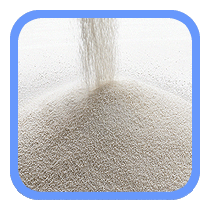Calcium Carbonate
Calcite as Limestone and Marble
Limestone is a sedimentary rock that is composed primarily of calcite. It forms from both the chemical precipitation of calcium carbonate and the transformation of shell, coral, fecal and algal debris into calcite during digenesis. Limestone also forms as a deposit in caves from the precipitation of calcium carbonate.
Marble is a metamorphic rock that forms when limestone is subjected to heat and pressure. A close examination of a broken piece of marble will usually reveal obvious cleavage faces of calcite. The size of the calcite crystals is determined by the level of metamorphism. Marble that has been subjected to higher levels of metamorphism will generally have larger calcite crystals.
What is calcium carbonate?
Calcium carbonate accounts for more than 4% of the earth’s crust. As a result, the three calcium carbonate minerals – calcite, aragonite and vaterite – are among the most important rock-forming minerals. Rocks are not the only calcium carbonate deposits in nature – almost all stretches of water and countless plants and animals contain huge amounts of calcium carbonate as well. These natural resources are linked by the calcium carbonate cycle.
Plants and animals absorb calcium carbonate in water, where it usually exists dissolved in the form of calcium hydrogen carbonate Ca(HCO3)2, and use it to build up their skeletons and shells. After their death, mussels, coccoliths, algae and corals form sedimentary deposits on sea beds and the rock-forming process is set in motion.
The first stage is the sedimentation process, from which chalk and limestone originate. Chalk is a poorly compacted sedimentary calcium carbonate rock whose diagenesis is incomplete.
Physical Properties of Calcite
| Chemical Classification | carbonate |
| Color | usually white but also colorless, gray, red, green, blue, yellow, brown, orange |
| Streak | white |
| Luster | vitreous |
| Diaphaneity | transparent to translucent |
| Cleavage | perfect, rhombohedra, three directions |
| Mohs Hardness | 3 |
| Specific Gravity | 2.7 |
| Diagnostic Properties | rhombohedra cleavage, powdered form effervesces weakly in dilute HCl, curved crystal faces and frequent twinning |
| Chemical Composition | CaCO3 |
| Crystal System | hexagonal |
| Uses | acid neutralization, a low hardness abrasive, soil conditioner, heated for the production of lime |
The construction industry is the primary consumer of calcite in the form of limestone and marble. These rocks have been used as dimension stones and in mortar for thousands of years. Limestone blocks were the primary construction material used in many of the pyramids of Egypt and Latin America. Today, rough and polished limestone and marble are still an important material used in prestige architecture.
Modern construction uses calcite in the form of limestone and marble to produce cement and concrete. These materials are easily mixed, transported and placed in the form of a slurry that will harden into a durable construction material. Concrete is used to make buildings, highways, bridges, walls and many other structures.

